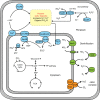Oxygen minimum zone cryptic sulfur cycling sustained by offshore transport of key sulfur oxidizing bacteria
- PMID: 29712903
- PMCID: PMC5928099
- DOI: 10.1038/s41467-018-04041-x
Oxygen minimum zone cryptic sulfur cycling sustained by offshore transport of key sulfur oxidizing bacteria
Abstract
Members of the gammaproteobacterial clade SUP05 couple water column sulfide oxidation to nitrate reduction in sulfidic oxygen minimum zones (OMZs). Their abundance in offshore OMZ waters devoid of detectable sulfide has led to the suggestion that local sulfate reduction fuels SUP05-mediated sulfide oxidation in a so-called "cryptic sulfur cycle". We examined the distribution and metabolic capacity of SUP05 in Peru Upwelling waters, using a combination of oceanographic, molecular, biogeochemical and single-cell techniques. A single SUP05 species, U Thioglobus perditus, was found to be abundant and active in both sulfidic shelf and sulfide-free offshore OMZ waters. Our combined data indicated that mesoscale eddy-driven transport led to the dispersal of U T. perditus and elemental sulfur from the sulfidic shelf waters into the offshore OMZ region. This offshore transport of shelf waters provides an alternative explanation for the abundance and activity of sulfide-oxidizing denitrifying bacteria in sulfide-poor offshore OMZ waters.
Conflict of interest statement
The authors declare no competing interests.
Figures





Similar articles
-
Morphological Plasticity in a Sulfur-Oxidizing Marine Bacterium from the SUP05 Clade Enhances Dark Carbon Fixation.mBio. 2019 May 7;10(3):e00216-19. doi: 10.1128/mBio.00216-19. mBio. 2019. PMID: 31064824 Free PMC article.
-
Giant hydrogen sulfide plume in the oxygen minimum zone off Peru supports chemolithoautotrophy.PLoS One. 2013 Aug 21;8(8):e68661. doi: 10.1371/journal.pone.0068661. eCollection 2013. PLoS One. 2013. PMID: 23990875 Free PMC article.
-
Decrypting the sulfur cycle in oceanic oxygen minimum zones.ISME J. 2018 Sep;12(9):2322-2329. doi: 10.1038/s41396-018-0149-2. Epub 2018 Jun 8. ISME J. 2018. PMID: 29884830 Free PMC article.
-
Dissimilatory sulfur cycling in oxygen minimum zones: an emerging metagenomics perspective.Biochem Soc Trans. 2011 Dec;39(6):1859-63. doi: 10.1042/BST20110708. Biochem Soc Trans. 2011. PMID: 22103540 Review.
-
[Oxidation of inorganic sulfur compounds by obligatory organotrophic bacteria].Mikrobiologiia. 2003 Nov-Dec;72(6):725-39. Mikrobiologiia. 2003. PMID: 14768537 Review. Russian.
Cited by
-
Metagenomic Profiling and Microbial Metabolic Potential of Perdido Fold Belt (NW) and Campeche Knolls (SE) in the Gulf of Mexico.Front Microbiol. 2020 Aug 11;11:1825. doi: 10.3389/fmicb.2020.01825. eCollection 2020. Front Microbiol. 2020. PMID: 32903729 Free PMC article.
-
Gulf of Mexico blue hole harbors high levels of novel microbial lineages.ISME J. 2021 Aug;15(8):2206-2232. doi: 10.1038/s41396-021-00917-x. Epub 2021 Feb 21. ISME J. 2021. PMID: 33612832 Free PMC article.
-
Diversity and ecology of microbial sulfur metabolism.Nat Rev Microbiol. 2025 Feb;23(2):122-140. doi: 10.1038/s41579-024-01104-3. Epub 2024 Oct 17. Nat Rev Microbiol. 2025. PMID: 39420098 Review.
-
Attenuation of wind intensities exacerbates anoxic conditions leading to sulfur plume development off the coast of Peru.PLoS One. 2023 Aug 30;18(8):e0287914. doi: 10.1371/journal.pone.0287914. eCollection 2023. PLoS One. 2023. PMID: 37647254 Free PMC article.
-
Autotrophic carbon fixation pathways along the redox gradient in oxygen-depleted oceanic waters.Environ Microbiol Rep. 2020 Jun;12(3):334-341. doi: 10.1111/1758-2229.12837. Epub 2020 Apr 7. Environ Microbiol Rep. 2020. PMID: 32202395 Free PMC article.
References
-
- Codispoti LA, et al. The oceanic fixed nitrogen and nitrous oxide budgets: moving targets as we enter the anthropocene? Sci. Mar. 2001;65:85–105. doi: 10.3989/scimar.2001.65s285. - DOI
-
- Gruber N, Sarmiento JL. Global patterns of marine nitrogen fixation and denitrification. Glob. Biogeochem. Cycles. 1997;11:235–266. doi: 10.1029/97GB00077. - DOI
Publication types
MeSH terms
Substances
LinkOut - more resources
Full Text Sources
Other Literature Sources

